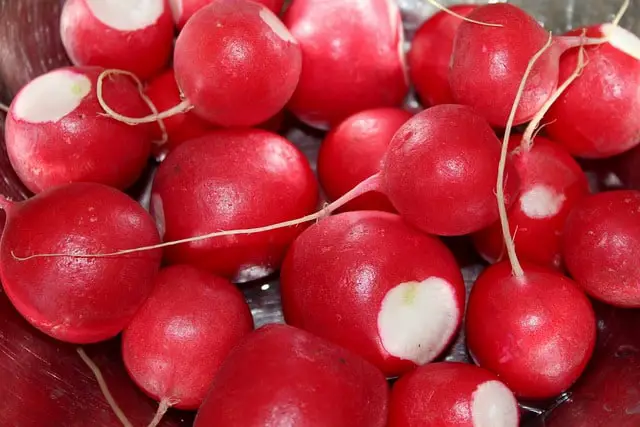There is a rumor circulating round the Internet claiming that radish and carrot cannot be cooked together because the carrot will release a compound which would destroy the vitamin C content of the radish.
How true is this rumor however?
This article is the final results of a thorough research and investigation, and the result is certainly not what you’re expecting.

You can cook radish and carrot together
Yes it is true the carrot contains a compound that can decrease the levels of a certain vitamin present in not only radishes but also itself when it comes in contact with the vitamin molecules. To be very specific, the vitamin we are all discussing here is Vitamin C and the compound is an enzyme called ascorbinase.
Given that fact, it is also the case that the vitamin content of any fruit or vegetable is always encapsulated and separated from the enzymes of that food.
This means that in carrots, you have the vitamin C content stored in the cell inside the fleshy part of the food, and then the enzymes (also packed) inside cells but in a much different location, usually towards the exterior part of the food, and the same thing applies to radishes.
So now during cooking, cells are naturally destroyed which cause them to release whatever is inside of them out to medium of cooking.
This means that both vitamin C and the ascorbinase would be released during cooking, however it is a well-known fact that almost enzymes are inactivated or destroyed at temperatures greater than 117°F.
And to add to that, even nutrients that are not heat stable would get destroyed to some extent which means part of the vitamin C would be destroyed during cooking – so a loss incurred already and ascorbinase has nothing to do with it!
The destruction of the ascorbinase means that it would not be able to make contact with the vitamin C molecules and destroy them.
Now things get even more interesting.
One also has to understand that vitamin C is a water soluble compound, which means that even when there is no ascorbinate to destroy the vitamin C, it would leach out into the liquid of the medium when cooking and dissolve leading to it’s overall reduction.
It has been estimated that about 50 to 60% of vitamin C is lost during boiling. A little less is lost when the method of cooking doesn’t involve a lot of water for instance, roasting, sauteing, grilling, etc.
So this means that there’s going to be a loss in vitamin C content sometimes as much as 50 to 60% without ascorbinate having anything to do with that.
Then, the vitamin C problem gets even worse. Vitamin C, aside from being soluble in water, also has the capacity to undergo oxidation with atmospheric oxygen and reduce.
This means that when you cut a radish or carrot or any fruit or vegetable that contains oxygen in half or whatever shape that exposes the flesh, some cells are destroyed which release vitamin C that then get exposed to atmospheric oxygen, oxidize and reduce in quantity.
All in all, we can see how vitamin C content is constantly reducing during cooking even without the presence of ascorbinate to cause this reduction, although the compound does have the capacity to reduce Vitamin C content when it comes in contact with it (as we’re going to see very soon).
Is eating carrot and radish poisonous however?
No, eating carrots and radishes does not pose any threat to human health. The strong evidence for this is found in the Bánh mi Vietnamese recipe that combines both carrots and radishes in slices in a sandwich. People have been consuming this recipe for many decades without having any complications whatsoever.
There are also many different recipes that incorporate both carrots and radishes together, for instance many asian soups and stews.
When the case can actually be true
Now, we know that the enzyme ascorbinase from carrots does have the capacity to reduce the vitamin C content in radish, but the only thing we have not seen is how this can happen in practice.
Well, here are a few cases.
When you chew both carrot and radishes together
When you chew both carrot and radish together, the chewing process does destroy some of the cells that contain both vitamin C and ascorbinase which cause a contact between the two compounds to occur and thus the reduction of vitamin C of course.
Remember that the chewing process is not that efficient, and very few cells are actually ruptured which means very little vitamin C is lost.
Another thing is that the destruction can only continue to happen within the perimeters of the mouth. The moment the chewed on food goes into the stomach, the high pH as well as unfavorable conditions there would instantly inactivate the enzyme and render it useless against the vitamin C.
Make juice
Then, another case is when you make a juice or smoothie.
By blending the radishes and carrots together, you’re destroying the cells which releases both the enzyme and the vitamin C. This time around, because the blender cuts through food particles finely than chewing, you have a lot of vitamin C, and ascorbinate released, which then allows contact between the two and a reduction in the Vitamin C.
There is a greater proportion of vitamin C lost here due to the fact that the enzyme can swim freely in the medium and destroy vitamin C without any hindrance.
When you cut the veggies
And then, by themselves, when you cut radishes and carrots and plate them, the exposed oxygen from the wounded cell would react with the atmospheric oxygen and get lost.
Does cooking radishes destroy nutrients?
Because radishes do contain a high amount of water vitamin C which is a water soluble vitamin, cooking them, especially by boiling does reduce the vitamin C content by about 50 to 60%.
Using any other method to cook however, can help preserve the vitamin C content a bit more.
The rest of the vitamin and mineral content are relatively stable during cooking, and even if they are lost, it’s in very small porpotions.
What vegetables should not be eaten with radish?
All edible vegetables can be paired with radishes for consumption. Feel free to add radishes to your favorite salad recipes and enjoy.
What do radishes pair well with?
When it comes to what radishes pair well with, given that they have a slightly sweet and peppery flavor, you will best enjoy them when you pair them raw with butter, grate them finely on risotto, stuff them into tacos, use them in sandwiches or eat them with scallops.

